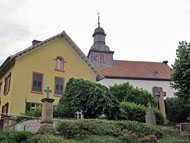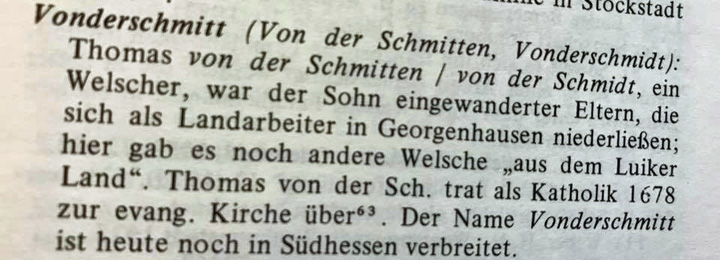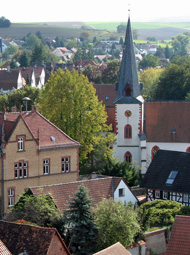Spachbrücken and Reinheim, Hesse-Darmstadt

The origins of our Vonderschmitt ancestors may be the most mysterious of any in our line, not chronologically but geographically. Thomas von der Schmiden (as it was then written, spelling being a mostly fluid art at the time) was born in 1640 but was referred to in local church books as "ein Welscher," a foreigner, so he came from elsewhere. You'll also see the spelling Vonderschmitt and Vonderschmidt.
"Welscher" in German usually meant someone specifically from outside the German-speaking region, such as someone whose native language was a Romance or Celtic language. It could refer to someone who lived on the French border as well as someone from Spain or Italy. There's a fascinating Wikipedia page that explores how various forms of this word for foreigner existed in almost all Indo-European languages. Thomas' surname "von der Schmiden" was not a title of nobility but likely a place name.

But new information may shed some light on the issue. The above abstract is particularly interesting regarding out ancestor. German genealogist Albert Esser provided this notation from the article "Wallonen in Südhessen" (Walloons in South Hesse) by historian Herbert Wilhelm Debor from the volume "Hessische Familienkunde" (Hesse Family History).
It says that Thomas Vonderschmitt, a foreigner, was the son of immigrant parents who settled as farm workers in Georgenhausen [near Reinheim, Hesse-Darmstadt]; there were other foreigners, "from the Luiker country" [i.e. the area around the Prince-Bishopric of Liège in the area referred to as Wallonia in present-day Belgium]. Thomas joined the evangelical church as a Catholic. The name Vonderschmitt is still common today in southern Hesse.
For more information on the linguistic origins of the Walloons from the "Luiker Land," read this article.
Also interesting is the fact that the proto-Germanic word *walha, from which Walloon derives, was used by German speakers to refer to Celtic and Romance language speakers, which further strengthens the interpretation of the word associated with Thomas, "Welscher" (see above). Available sources certainly suggest that Thomas was a particular type of foreigner with an identifiable linguistic heritage living in and around Georgenhausen and Reinheim, and that there were others like him nearby, including his unnamed parents.
Thomas' married his first wife, Christina Bentz, in 1666 in Spachbrücken. Christina was from far afield too. She came to Spachbrücken from a town transcribed as Pein in Pommerania. This may be Pcim in present-day Poland. Thomas and Christina had four children before Christina died in her late twenties.

The death record for Christina at left suggests a life fraught with resettlement and unknowns: "Christina, wife of Thomas Schmidt at Spachbrücken was buried, age 28 or 29 years, because she was fathered in warfare one could not know the exact number [of years of her age]. Her mother's name was Anna Bentz from Pein (?) in Pommern (serving as a maid for Wendel Neeb and died May 13, 1657), but who Christina's father was, nobody could know." Thomas remarried Anna Forch, widow of Johann Heinrich Maÿer, in 1676 and died in 1690 at the age of 50.
The Thirty Years War was probably responsible for all this uncertainty. Its disruption to peaceful family life paved the way for many such migrations from region to region. Although Thomas and Christina were strangers in Hesse-Darmstadt, their descendants have been settled comfortably in this area for three centuries, and cousins of ours exist there today.
Thomas' eldest son with Christina was Johann Heinrich, born in 1667 in Spachbrücken, though he resettled in Überau. Around 1690 he married an Elisabetha Catharina (her original surname is not known and their marriage record is evasive). They had five sons. The eldest's baptism record, which should have been entered into the church book at Reinheim, is also evasive but we believe he was Johann Nicolaus Vonderschmitt, born in 1690.
In the absence of clear documentation we rely on circumstantial evidence to suggest that Johann Nicolaus was the son of Johann Heinrich. Johann Nicolaus, a "Schreinermeister" (master carpenter) in Überau had eight children with his spouse Maria Christina. Johann Heinrich was a godparent to three of them. Johann Heinrich's sister (and thus Johann Nicolaus' presumed aunt) Elisabetha Catharine Rückert was a godparent, so was her daughter. And Johann Heinrich's second son Johann Georg was also a godparent as was Johann Georg's own son. The presence of so many potential relatives suggests a close familial relationship.
Johann Nicolaus' eldest son, Johann Georg, was born in 1720. Breaking with tradition he became not a carpenter but a forester or groundskeeper for a local prince. Johann Georg's 1753 marriage to Elisabetha Margaretha Frey in Reinheim resulted in nine children. One daughter, Elisabetha Margaretha Vonderschmitt, married Georg Philipp Schuchmann, a braid and lacemaker in Reinheim.
The Schuchmanns are well known to us and were established in the Reinheim region as far back as the middle 1500s. Elisabetha's marriage to Georg Schuchmann resulted in several children, including a son, Johann Ludwig Schuchmann (1805-1872), who became a well-known haberdasher in Charleston, South Carolina.
Many thanks to Albert Esser, who has done excellent research in the region and helped us to unravel the roots of this tree.